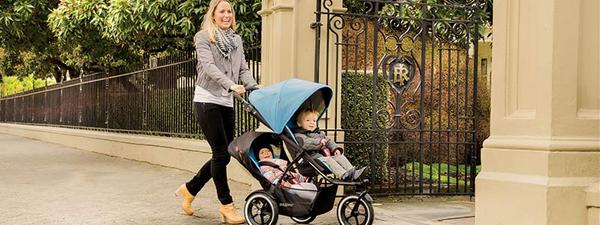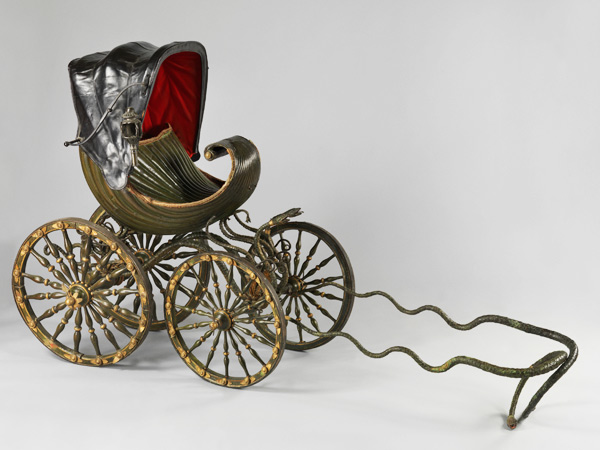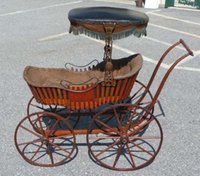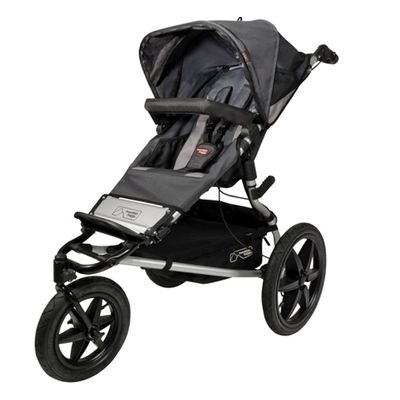 In its short 300 year history, the stroller has come a long way. In fact, prior to the 1700’s, the go-to mode of transportation for a baby was a hip. That all changed in 1733 when the Duke of Devonshire asked a well-known garden architect, William Kent, to build a means of transportation that would amuse his children. In response, Kent designed a shell shaped basket on wheels in which the children could sit. Equipped with a harness so it could be pulled by a goat or small pony, and springs so the Duke’s children could ride in comfort, the first “baby carriage” was born.
In its short 300 year history, the stroller has come a long way. In fact, prior to the 1700’s, the go-to mode of transportation for a baby was a hip. That all changed in 1733 when the Duke of Devonshire asked a well-known garden architect, William Kent, to build a means of transportation that would amuse his children. In response, Kent designed a shell shaped basket on wheels in which the children could sit. Equipped with a harness so it could be pulled by a goat or small pony, and springs so the Duke’s children could ride in comfort, the first “baby carriage” was born.

The First Carriages
In an Age of Enlightenment version of “Keeping up with the Joneses,” when other wealthy parents saw the Duke’s new contraption, they rushed to have replicas built for their own children. However, the cost associated with doing so was hefty, and therefore the baby carriage quickly became a symbol of status and wealth.
Over the next several years, a number of modifications were made to the baby carriage’s design, the most notable being the addition of handles so parents could push their children instead of relying on goats to pull them. Clearly, this new design went over well with Queen Victoria, who, in the 1840’s, bought three carriages from Hitchings Baby Stores of Ludgate Hill. And, just as if it were Victoria Beckham purchasing a stroller today, once Queen Victoria bought her carriages, anybody who was anybody rushed to buy their own. Anybody with money to spend, of course.
Time for a Change

In addition to the fact that they were exceptionally expensive, the problem with the baby carriages of the time was that they were too tall and unstable to be safe. They also had solid axles that limited wheel movement (the front two wheels moved together, as did the back two). But over the next several years, a variety of design modifications and upgrades were made. One such modification is credited to a man named William H. Richardson, who on June 18, 1889 submitted an idea to a Baltimore patent office for a baby carriage that used a special joint allowing for the bassinet to be turned to face the operator, or away from the operator as in conventional carriages of the day. Richardson also made some significant improvements to mobility by creating axles that allowed for each of the carriage’s four wheels to turn independently.
The Market Opens
 Fast forward thirty years to the post WWI baby boom of 1920. The massive increase in births in such a short period of time dramatically opened the market for baby carriages for all income levels and classes, and drew attention to the issue of safety for the first time. Over the next several years, footbrakes became standard, baskets were deepened so children would have a harder time getting out of them, and the carriages themselves were designed lower to the ground, so if a child did happen to fall/jump/escape their basket, they wouldn’t have quite so far to fall.
Fast forward thirty years to the post WWI baby boom of 1920. The massive increase in births in such a short period of time dramatically opened the market for baby carriages for all income levels and classes, and drew attention to the issue of safety for the first time. Over the next several years, footbrakes became standard, baskets were deepened so children would have a harder time getting out of them, and the carriages themselves were designed lower to the ground, so if a child did happen to fall/jump/escape their basket, they wouldn’t have quite so far to fall.
Rubber and plastic began replacing the old school wicker and wood models, wheels increased in size, and chrome also became more prevalent, replacing brass and other metals used in earlier years. By the early 1950’s cheaper materials and safer designs made a baby carriage an affordable must-have for every new parent. But they weren’t perfect.
The Stroller As We Know It
The collapsible modern strollers we see in stores today are the brainchild of aeronautical engineer and test pilot Owen Maclaren. Just like many inspirational invention stories, Maclaren’s idea to create a carriage that was compact and lightweight was sparked by a desire to fix the problem of a loved one. In Maclaren’s case, it was his daughter’s complaints about a recent trip from the US to Britain and how cumbersome her baby’s carriage was to tote around that led him to use his knowledge of airplane manifolds to forever change the baby carriage world. In 1965, he designed the “umbrella stroller” – the first true baby “buggy” that used a light-weight aluminum frame that had amazing load bearing capabilities, could fold down into a compact size, and was safe enough for even his grandchildren to ride in.

Aspects of Maclaren’s innovative designs are still seen in the majority of strollers on the market today. However, while the basics remain the same, these days purchasing a stroller has less to do with safety and structure—those come standard—and a lot more to do with lifestyle and fashion.
In 1980, Phil Baechler invented the jogging stroller after he became increasingly frustrated with trying to run and push his son simultaneously. Now, jogging strollers are the go-to for active parents. For those parents looking for even more manoeuvrability, there are all-terrain strollers, which are easier to steer than jogging strollers, making them equally suited for the outdoors and the mall.
There are also combo strollers. Consisting of a toddler stroller base and coordinating infant bassinet, combo strollers work from infancy through to toddlerhood. And of course, there are bike trailers (in which I have seen Vancouverites tote their munchkin sized dogs), which are perfect for parents who want to take their children along for their bike rides, but want something a little safer than a child bicycle seat.
No matter what your lifestyle, there is a stroller out there to suit your needs; and you can be sure to find one with the added accessories you need and the colour you want as well. You need a cup holder and want pink polka dots? No problem! You have twins and like to jog? No problem!
Strollers really have come a long way, baby.



